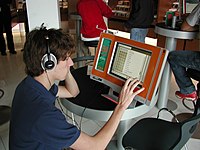
Photo from wikipedia
Investigations of neuromuscular control of voice production have primarily focused on the roles of muscle activation levels, posture, and stiffness at phonation onset. However, little work has been done investigating… Click to show full abstract
Investigations of neuromuscular control of voice production have primarily focused on the roles of muscle activation levels, posture, and stiffness at phonation onset. However, little work has been done investigating the stability of the phonation process in regards to spontaneous changes in vibratory mode of vocal fold oscillation as a function of neuromuscular activation. We evaluated 320 phonatory conditions representing combinations of superior and recurrent laryngeal nerve (SLN and RLN) activations in an in vivo canine model of phonation. At each combination of neuromuscular input, airflow was increased linearly to reach phonation onset and beyond from 300 to 1400 mL/s. High-speed video and acoustic data were recorded during phonation, and spectrograms and glottal-area-based parameters were calculated. Vibratory mode changes were detected based on sudden increases or drops of local fundamental frequency. Mode changes occurred only when SLNs were concurrently stimulated and were more frequent for higher, less asymmetric RLN stimulation. A slight increase in amplitude and cycle length perturbation usually preceded the changes in the vibratory mode. However, no inherent differences between signals with mode changes and signals without were found.
Journal Title: PLoS ONE
Year Published: 2022
Link to full text (if available)
Share on Social Media: Sign Up to like & get
recommendations!